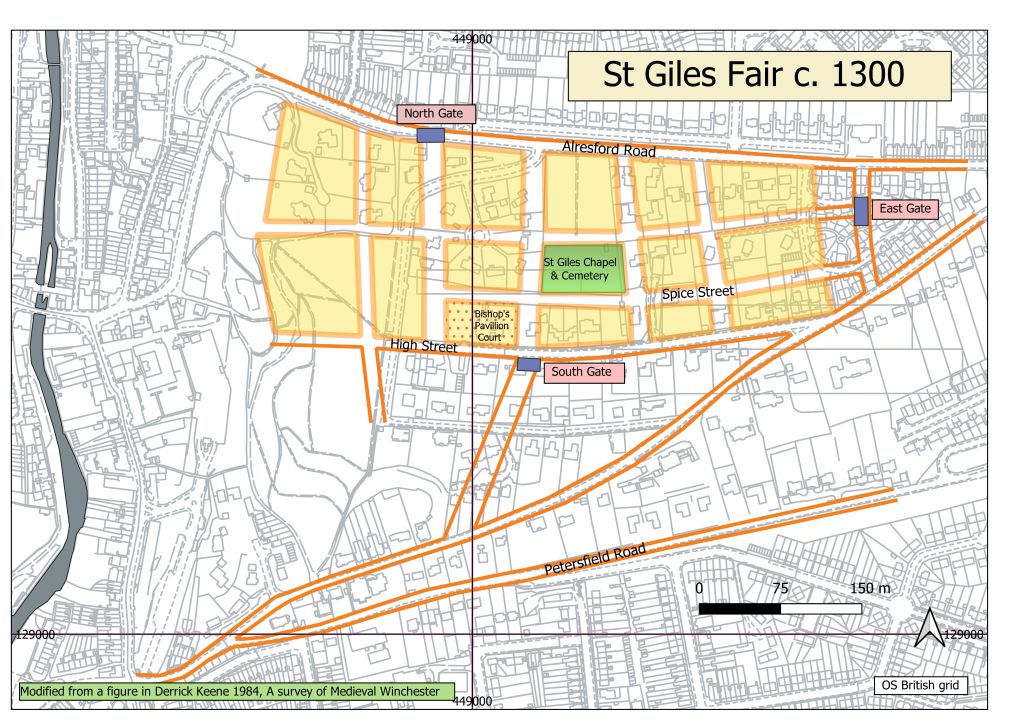Ancient St Giles Hill
St Giles Hill sits un the east side of Winchester, the city's old East Gate (now demolished) below. In medieval times St Giles Hill was referred to as East Hill. It overlooks the East Soke of the city and had probably been important as a meeting place since early times. The hill takes its name from a medieval chapel or church that stood on the hill. The hill and chapel were first mentioned in 12th century texts but archaeological evidence suggests that humans used the site from early Palaeolithic times. The Romans and the Anglo-Saxons used it as a burial ground.

Bronze age urn found on St Giles Hill
The use of St Giles Hill by Bronze age peoples is evidenced by the small bronze age cinerary urn shown below. It is made from a coarse grog-tempered fabric with reddish patches. It originally had a decorated collar with a twisted cord design (only a fragment survives). The item is stored in the Winchester Museum archives. An old label says it was presented to the museum by Alderman Thomas Stoper j.p.
Several Roman finds have been reported from the site of St Giles Hill Graveyard or close to it. The location of the finds is only approximate. These include the 19th c discovery of a tessellated pavement, in 1894 some Roman vessels, and various finds in the 19th and 20th c., and in 1827 in St Giles Cemetery a Roman coffin. 19= inhumation (1978)
The most impressive is (HER ID: 27087 and 27088) a complete Roman coffin made out of chalk discovered at St Giles Hill. by workmen excavating for a vault. The coffin contained a perfect human skeleton dressed in linen and sandals, as well as a metal urn. The date of discovery is given as 1968 but it is probably the same find as listed by Patrick Otterway as 1827.

Roman fines on St Giles Hill
Anglo-Saxon St Giles Hill
St Giles Hill was the site of an Anglo-Saxon cemetery.

Anglo-Saxon St Giles Hill
The St Giles Hill Anglo-Saxon cemetery is one of several in the Winchester area. Details of its burials are not well known because they were discovered in the 19th C before rigorous archaeological recording became commonplace. Others at Winnall, Twyford, and Worthy Park are better known because they were excavated in the 20th C. Anglo-Saxon funerary practices included cremation, burrow burials, and Inhumation burials. Inhumation burials are the most common in Hampshire including at St Giles Hill and the nearby cemeteries. Burials were made without a coffin to a depth of about 60cm on Chalk. They often contain grave goods, items that belonged to the person during life.
The image below is a clip from the Hampshire section of "A Gazetteer of Early Anglo-Saxon Burial Sites" by Audrey Meaney (published in 1964). It lists some of the known Anglo-Saxon finds from St Giles Hill. Many of the 19th C finds from St Giles Hill were donated to Winchester Museum (between 1850 and 1905). Most are metal objects that are kept in the sensitive store of the museum at Bar End and considering their age are reasonably well preserved. A few items are also on display in the City Museum on the 1st floor. This sword pommel is one of them.
Many of the objects are weapons buried with male Anglo-Saxons. Such burials were common between the 5th and 7th C. But as Christianity became established in Southern England in the late 6th C burial practices changed heralding the end of weapons burials.
Such burials were probably rare after the founding of the Old Minster, Winchester's first Christian church in 648.

Excerpt form the publication a "Gazetteer of Early Anglo-Saxon Burial sites"
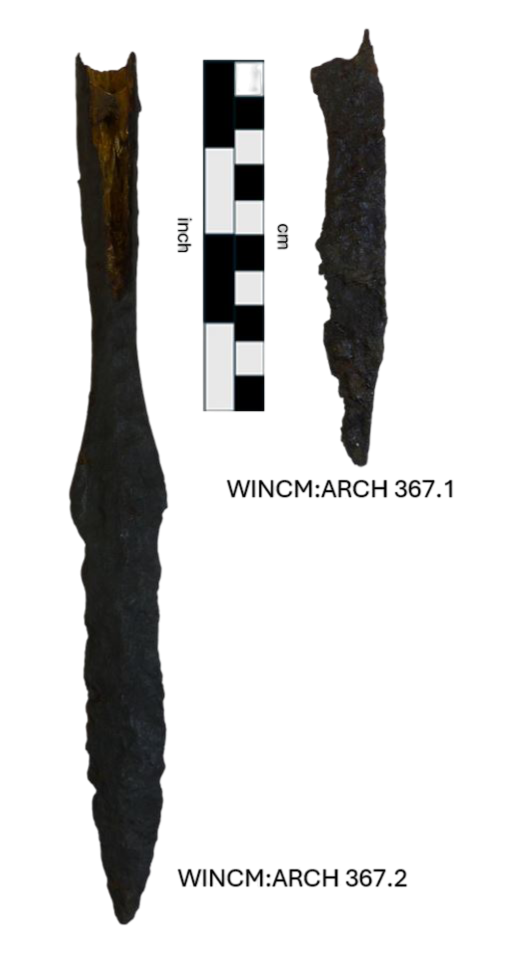
Anglo-Saxon artifacts found in the gardens of Palm Hall date uncertain.
Burials have been unearthed in areas flanking the west end of Northbrook Avenue and near St Giles Hill Graveyard. The discoveries occurred during intense building activity on St Giles Hill as it was developed as a residential area.
Items WINCH:ARCH 367.1 and 367.2 are cataloged as being found in the garden of Palm Hall. These could be the two items listed in the gazetteer as being found in Palm Hill Garden in 1844. This might be an error, the correct date being 1894. The accession number suggests the find date would be earlier.
In 1905, several graves were found when a summer awning was being put up in the garden of High House (now renamed Earlsdown). The graves contained goods including 2 spearheads a dagger, a ferrule, and a silver ring.

Five Anglo-Saxon knives from St Giles Hill.
To the left five of 6 Anglo-Saxon Knives that were mentioned in an article in the Hampshire Chronicle in 1894. The tweezers below were also noted.
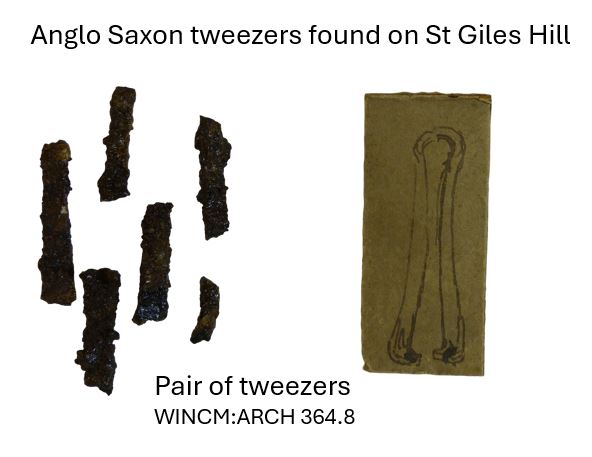

Location of Palm Hall and High house (renamed Earlsdown) - 25" OS map 1894

Sheild bosses, sheild rivets and spear found in 1894

Glass beads presented to museum in 1894
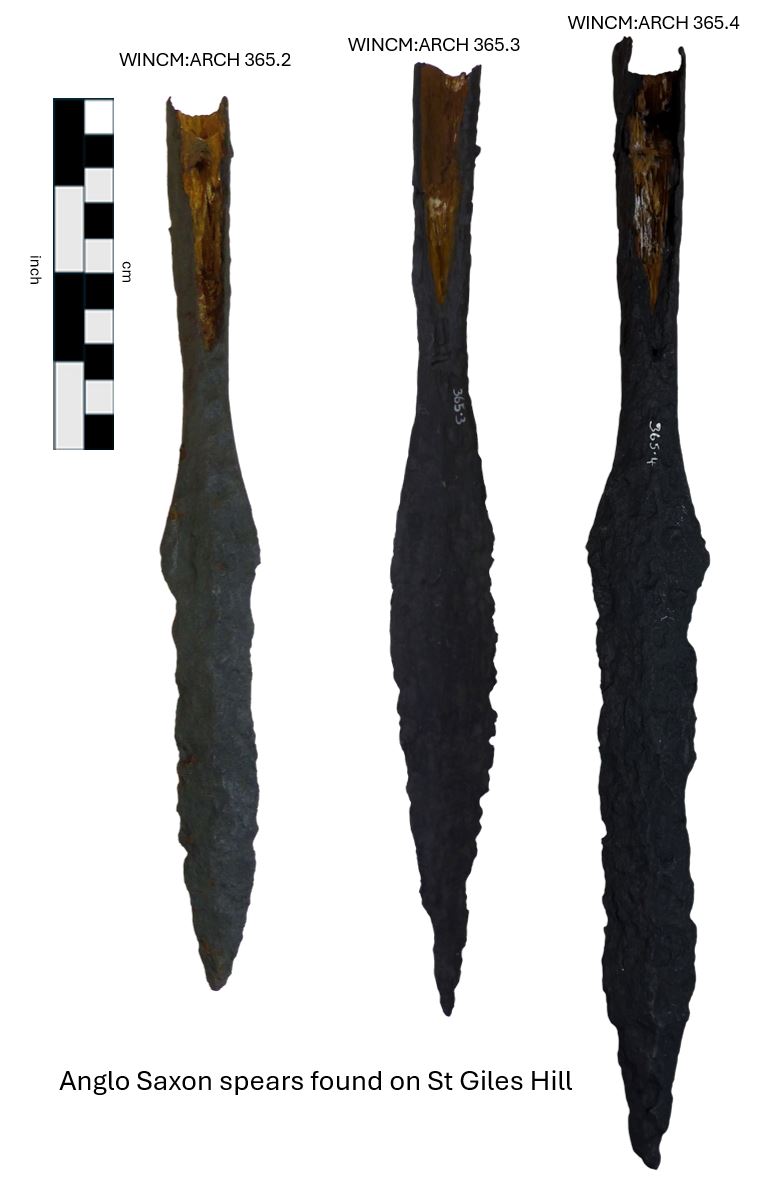
Anglo-Saxon objects from St Giles Hill
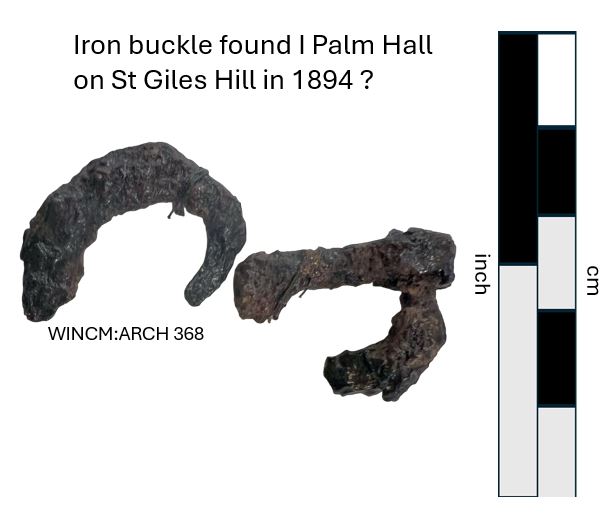 Several finds were presented to the museum by Alderman Jacob from Palm Hall (probably found 1894). These include glass beads (WINCM:ARCH 369-4), a large annular bead of yellow glass, and several smaller blue bands with ornamental shapes.
Several finds were presented to the museum by Alderman Jacob from Palm Hall (probably found 1894). These include glass beads (WINCM:ARCH 369-4), a large annular bead of yellow glass, and several smaller blue bands with ornamental shapes.
WINCM:ARCH 368 is a small buckle in two pieces.
The age of the burials on St Giles Hill can be gauged from the topology of the shield bosses found in association with the burials. On the schematic diagram below the best match is with those of the late 5th and early 6th centuries.

Topological and Chronological sequence of 5th to 7th C Anglo-Saxon sheild bosses
It is not known if the cemetery continued to be used between the 8th C and the Norman conquest. We do know that in 1080 St Giles Chapel and Cemetery occupied the location. Perhaps St Giles Chapel was predated by an Anglo-Saxon church.
St Giles Hill Fair
St Giles Hill is also important as the site of St Giles Fair, one of the largest and most profitable medieval fairs in Western Europe. The fair was held annually from 1096 on the three days of the Saint's vigil, the feast day on 1st September, and the day following. It reached its peak in the 13th century and then declined in importance. It attracted merchants from many lands. The fair supported a permanent settlement ‘Nova Villa’ whose site included the flat land on top of St Giles Hill and extended eastwards to include Magdalen Hill Down.
